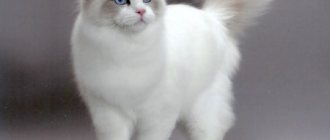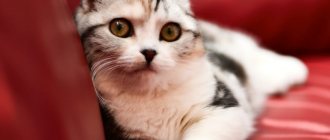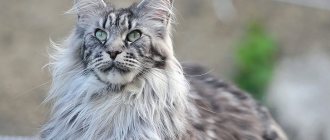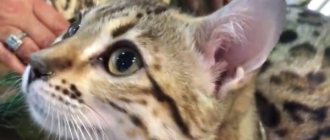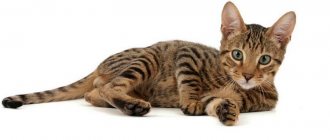This breed stands out from the rest with its silver-blue color and piercing green eyes. Russian blue cats are “real noblewomen”... graceful and mysterious creatures that delight their owners with their special charm and obedient disposition.
What are the differences between representatives of Russian blue cats, besides the amazing color?
- Body type . The body is medium (sometimes large) in size. The body is neat and slightly elongated. Russian Blue cats are characterized by flexibility and grace.
- Head . Wedge-shaped, with a powerful chin and large wide ears. Wide-set expressive eyes and a long straight neck.
- Tail . Sufficiently long in size with a pointed tip, the shade and density of the coat is no different from the rest of the silver color.
- Limbs . Long and thin, with round or oval feet. Possessing the plasticity of a panther, Russian Blue cats walk very softly and gracefully.
- Wool . The “coat” of this breed is short and dense, but unusually soft, like plush. Color – deep blue, almost blue, with a silver tint.
The eye color of Russian Blue cats is only green, but there are a lot of options, from a light pale green shade to a rich dark emerald color.
Where she came from?
The first documented facts about the origin of silver cats date back to 1893, when the breeder Mrs. Carew-Cox bought the first animals, which officially began the Russian Blue cat breed.
She wrote in her diaries that her favorites came to Great Britain from Arkhangelsk. The sailor who sold her the cats told her that such silver-blue cats could be found in villages in the north of the Russian Empire. To withstand the frost, the Russian Blue cat had to acquire a thick, fluffy double coat - a dense, smooth coat on top, and a soft, abundant undercoat underneath.
The silvery "blue" coloring was typical of many English cat breeds and they were bred together for a long time. The division occurred in 1912, from that moment the Russian blue cat had the opportunity to begin an independent path.
At the beginning of its formation, the appearance of the breed was different from what is familiar today. The first cats entered into the stud book were medium-sized, densely built animals, with a round head and oval-oblong ears.
The breed acquired its modern appearance later, in the middle of the last century. During World War II, the number of Russian Blues dropped so much that breeders decided to use Oriental cat breeds for breeding. This mixing gave the Russian Blue cat grace and a sophisticated silhouette, but spoiled the color - kittens began to be born of a color atypical for the breed.
Russian blues came to Russia from Czechoslovakia at the end of the last century.
Story
As is already clear from the name of the breed, the homeland of Russian blue cats is Russia, namely Arkhangelsk. But there are no reliable sources on how, when and by whom this breed was bred. Archival documents have been preserved to this day, which say that blue cats come from the Arkhangelsk region. Tsar Peter I adored them, and Empress Catherine II, who preferred dogs more, gave blue kittens to representatives of the upper classes and foreign rulers as a sign of her favor. So Russian blue cats became very popular abroad, especially in Great Britain, being considered a sign of wealth.
Before the Russian blue cat came to European countries, there were already similar “brothers” there, which were called Spanish and Maltese. To avoid confusion, in 1930 this breed received the official name: “Russian Blue”.
Since then, many attempts have been made to obtain other shades of this breed, but they were all in vain - there are still only two colors: blue and silver.
It is interesting that Russian blue cats were not particularly popular in our country until the 80s of the last century, but today they are one of the most preferred and popular breeds.
Standards
The Russian Blue cat breed is recognized by all felinological organizations, each of which has adopted its own breed standard. In some respects they are similar, in others they have significant differences.
Today the breed includes the following types:
- English;
- European;
- American.
- Australian.
The first and last are similar to each other, but Europeans and Americans are significantly different.
Color and coat
The Russian Blue cat is prescribed to have a gray-blue color with a silver tint. This coloring is obtained due to the fact that each hair at the end has a lightened, almost white area and the fur seems to sparkle in the sun.
In the American type, the lightest color option is considered more preferable. In European style, moderate blue, mid-tone tones are considered the best.
Due to their pale coloring, Americans look more fit. On darker Europeans, the silvery tint characteristic of the Russian Blue cat is more noticeable.
Markings and uneven coloring are considered serious faults.
By all standards, the Russian Blue cat's coat is soft, silky and very thick. The undercoat and topcoat should be the same length and stand on end - not adjacent to the body.
Addition
The Russian Blue cat breed has an elegant and graceful build. Cats are significantly larger and more powerful than females. Standards require the Russian Blue cat to have well-developed muscles, a light build, and long bones. The overall silhouette should be flexible and delicate. Roughness and massiveness are considered disadvantages.
Head
The Russian Blue cat breed stands out among all other breeds with its facial expression and muzzle structure. The head should be wedge-shaped, the nose and forehead should be flat.
Different standards differ regarding the pinch - the special structure of the whisker pads that seem to stick out on the muzzle. According to the European standard, the Russian Blue cat is supposed to have a distinct pinch, while the American prefers smoother lines of the muzzle.
Eyes
In any type, the structure of the head allows the Russian Blue cat to attract maximum attention to its eyes. They should be a bright, rich green color, which is often compared to the sparkle of emeralds.
The Russian Blue cat is not allowed to have other colors and dull shades in any type.
Opinions differ regarding the shape of the eyes. Americans want a round shape, Europeans prefer an elongated, almond-shaped one.
Tail
The American type requires a long, moderately thick tail that is curved at the end. Europeans have a tail that is thick, even and of medium length.
Paws
When it comes to paws, standards differ the most. In the American type, the paws should be small and rounded, and the pads should be gray or gray-pink in color. The European Russian Blue cat is supposed to have oval paws, medium-sized and strictly pink in color.
Appearance and standards
The Russian Blue cat belongs to that category of creatures that may not initially make a stunning impression, but then many find themselves thinking that the more you look at them, the more you like them.
Head and muzzle
The head is shaped like a modified wedge. The bridge of the nose is straight. The vibrissae pads are well developed. Pinch is missing. The eyes are almond-shaped, large, and set wide apart. The color of the iris is any shade of green, solid and rich, preferable. The ears are large, set vertically, wide at the base, and pointed at the tips. The nose is gray-blue. The chin is strong.
Body type
Lightweight, elongated body. The bones are not too heavy, the muscles are moderately well developed. The legs are long, light and thin. Paws are rounded. The pads are dark lavender. The tail is straight, gradually tapering to a thin tip.
Coat and color
The coat is double (undercoat and hair are of equal length), so it seems very thick. The hair does not fit tightly on the body, it feels soft and silky. The color is even throughout the body, bright blue, lighter colors are preferred. The guard hair is tipped (the tip is devoid of pigment), which is why the fur coat shimmers with silver.
Character and behavior
The Russian Blue cat is said to be a kind and affectionate animal. Representatives of the breed are distinguished by a calm character and balanced temperament. They will happily play with the owner or his children, but will not force communication.
Kind and affectionate with members of their family, these purrs are reserved towards strangers and try to avoid them.
Representatives of the breed usually have highly developed hunting instincts. It doesn't cost a Russian Blue cat anything to catch a mouse or even a rat. If rodents are not caught, they will eagerly hunt birds and insects.
At the same time, the Russian Blue cat breed easily puts up with the owners’ other animals: make friends with a dog, and a poultry or hamster will be completely safe.
Where and how best to buy a kitten
It is best to buy a purebred baby from felinologist breeders.
Felinologists are fans of their work. They register the nursery, conduct breeding work, and take part in exhibitions. And experts are invited to make a preliminary assessment of the pet’s class.
In the photo there is a Pokemoshka cat with a kitten from the Razdolie nursery, Moscow.
Their daily work and material expenses add up to the price of a purebred kitten. It is clear that the breeder will sell a show-class graduate at a price of 40,000 rubles, and a pet-class baby, that is, without the right to participate in exhibitions and breeding, can be bought for 20-25 thousand rubles.
A proven, popular Russian Blue nursery must have a page on social networks, and a website has been created with photographs of graduating children and their titled parents. For example, the RG “Razdolie” nursery in Moscow.
On the blog you can always:
- read customer reviews,
- find out the features and characteristics of pets.
- Take contacts and reserve a kitten.
The breeder gives advice on what to buy and how to prepare for the baby’s arrival. Talks about a kitten. Gives advice on caring for your furry cat. Reviews natural nutrition and dry food.
Today, daily video reviews of the everyday life of the cattery are popular among cat owners. From them you can find out how the kittens were born, what they eat, and in what conditions they grow. Even the video already makes it clear what character, habits and preferences the booked baby has.
Care
The Russian Blue cat breed is a very easy to care for pet. The short, elastic coat does not require additional brushing. Even for an exhibition, it is enough to wipe the cat with a cloth with a small amount of conditioner for shine and the animal will look luxurious.
In everyday life, a healthy cat takes care of its own toilet and makes sure its fur is clean and tidy.
The breed is not characterized by heavy seasonal shedding. Dead fur is replaced evenly throughout the year and there are no periods when everything around is covered with shedding wool.
Like any other cat, the Russian Blue cat needs the opportunity to sharpen its claws. To do this, you should put a special sharpener or a small stump in the corner.
Regular dental and ear checks will help prevent health problems.
Russian Blues are very neat animals and are easily trained to use the toilet in a tray, and even to use the toilet.
Health and life expectancy
The breed does not have any genetic diseases or predisposition to certain diseases. The breeders have done a lot of work to achieve such results. But this does not mean that a cat cannot get sick. Like any other, it is susceptible to all sorts of contagious and non-contagious diseases. But many of them can be prevented by timely vaccination, proper care and a balanced diet. Average life expectancy is 13-14 years.
Nutrition
A healthy cat has a good appetite and is unpretentious in food. Natural feeding is best for Russian Blue cats. These are not leftovers from the owners' table, but raw meat with bones, such as chicken wings or legs. Cats, despite many generations of living next to people, remain strict predators and are poorly adapted to digest plant foods.
The Russian Blue cat breed does not always fully absorb milk and dairy products, and should be given with caution.
Raw river fish may not be suitable for a Russian Blue cat, but it is useful to give sea fish at least once a week.
Under no circumstances should you give your Russian Blue cat boiled fish or boiled and fried bones!
If the owners do not have the opportunity to feed the cat natural food, the Russian Blue can also eat industrial ready-made food or “human food”. In this case, it is important to take care of clean water; when fed naturally, cats drink little, they only need moisture in the meat.
A healthy Russian Blue cat does not need vitamin supplements.
Pros and cons of content
Purity
When a green-eyed pet with thick fur leaves little hair in the apartment, this is a big plus. The whole point is that the dense undercoat holds the fallen guard hairs until the owner cleans the animal with a caring, damp hand. Wool mostly accumulates on beds, rather than flying in the air.
Tip: It is good to use a pimply mitten or a furminator for short-haired purrs to collect lost hair.
Hypoallergenic
This is an important advantage of the breed. Because the double texture of the “hare” fur skin does not allow skin scales to fall out, which means that the risk of a person’s allergies is minimized. After all, the irritant is not fur, but cat dander. It is she who provokes a runny nose, itching, and redness of the eyes.
Cleanliness
Cats are clean animals, this is their big advantage.
But there is also a minus in the scrupulous neatness of the “Russians”: they only go into a clean pot with fresh filling. And if the owner forgot or did not have time to clean the tray, then wait for a “surprise” nearby or in a secluded corner.
Who is a Russian Blue cat suitable for?
The Russian Blue cat breed is suitable for almost anyone who wants to have a calm and reliable friend.
The good nature, sociability and non-intrusiveness, responsiveness in play and communication characteristic of the Russian Blue cat make it an ideal pet for families with children. Docile and non-aggressive, Russian Blues will not resist a child's desire to cuddle a cat and are durable enough not to be accidentally damaged in play. They will be equally willing to run after a bow and purr on their knees, learn tricks and quietly wait for their owners to return home.
The Russian Blue cat breed is not characterized by wild games and excessive activity, characteristic of Oriental cats, but they cannot be called “real estate” like their English feline relatives.
Maintenance and care
The content does not contain any special recommendations, but it is worth noting some timidity, which should not be confused with cowardice. Caution towards strangers will remain forever, so there is no need to drag your cat out from under the bed in the presence of guests. Early socialization will help smooth out this feature a little. Russian Blues prefer stability and have a hard time with moving or changing their usual environment. Adaptation in kittens and adult animals takes quite a long time. If your cat has free access to the outdoors, she will be happy to go out, hunt and bask in the sun, but is unlikely to stray far from home.
Care
Care is extremely easy. Russian Blues are exceptionally clean and are ready to lick themselves at every opportunity. It is not worth bathing them often. Unless during heavy molting you can bathe and comb your pet.
Because of their cleanliness, blue cats are often picky about the cleanliness of the litter box. If the owner does not have time to clean, the cat will find another place.
In rare cases, long claws do not grind down well on their own and prevent the cat from moving freely, especially on carpeted floors. Then they need to be carefully trimmed with scissors or a special pruner.
This cat loves high places. Her personal space is ideally her own house, covered with a roof and located at an average height from the floor. A cat feels uncomfortable when sleeping in an open space, so bedding and beds are not for her.
It is better to take a bowl for food from metal; it is good if it is stable. It is better to move the tray away from the animal’s usual location, for example, it could be the bathroom.
The cat will feel comfortable, even in a small room, because it is a fairly miniature animal. The Russian Blue does not need frequent walks, although it does like fresh air. An animal can play with anything; today you will see a cat enthusiastically attacking a teddy bear, and tomorrow it will already be chasing a ball of thread.
Diet
In terms of nutrition, this breed is not whimsical; a well-balanced food and sprouted herbs are enough for the Russian Blue cat to feel great and be happy for many years.
If you have chosen a natural type of feeding, then it is worth knowing that animals are given milk and meat at the same time. The best meat is chicken, lean beef. Regarding dairy products, it is better to give cheese, cottage cheese, natural yogurt, sour cream. It is not advisable to give your Russian Blue cat cow's milk or fatty fish.
If you decide to stick to food, choose good quality products:
- Hill's;
- Sheba;
- Advance;
- Royal Canin.
Premium quality products will help maintain the beauty of your pet's coat and its health. It is even better to create a combined diet, where 75% dry food accounts for 25% canned products.
If you notice that the Russian Blue's coat has begun to turn brown, the reason most likely lies in foods containing copper: liver, legumes, shellfish.
What to look for when choosing?
Before buying a kitten, you should decide on the desired type.
Americans are slightly smaller, lighter in color, with a longer tail and narrow muzzle, and have a more active character.
Europeans are larger, darker, but their fur shimmers more, with an expressive face and a phlegmatic temperament.
Important points when purchasing:
- the kitten must be playful and healthy, the Russian Blue cat is not supposed to ignore bows and wiggling fingers;
- If you are planning a show career, pay close attention to the color of the eyes and coat of your purchase - they will not change with age!
- meet the parents of the future pet: you should not expect a good kitten from sick animals, with a bad character or a non-pedigreed appearance.
Where to buy?
A future show star can only be purchased from a nursery that professionally breeds this breed. It is difficult for Russian Blue cats to succeed at shows, so you need to choose very carefully.
See how the kitten's parents and his brothers and sisters from previous litters won exhibition victories. Do not forget that different international organizations describe the standard differently and a Russian blue cat of the European type is not in danger of success in the American association.
You can simply adopt a pet from neighbors or friends, but in any case it is worth meeting the mother and father of the kitten to make sure of their breed.
Under no circumstances should you buy a cat at the market! The Russian Blue cat breed cannot be there, only yard cats similar to them.
A little history of the breed
“Russian Blue” was bred by the English felinologist Karen Cox and registered as a separate breed of “foreign type” in 1935.
But the ancestors of these green-eyed beauties were the Arkhangelsk smoky-gray rat catchers. It was these that Karen brought to England from the north of Russia back in 1888.
Since 1889, Karen Cox has kept a diary where she records pairs of parents. "Rusakov" is crossed with blue British shorthairs. Selects kittens with characteristic features, fills in the family tree of the pets and, if possible, photographs them.
The felinologist registers the results of selection work and exhibits graduates at international exhibitions.
Victories, disappointments, again, good luck. New pairs for mating. Birth of kittens. And, finally, the worldwide recognition of the Russian Blue as a separate breed has taken place.
Interesting fact:
until 1912, the “Russians” retained the name “Arkhangelsk”. Although the Pomors called the local smoky rat-catchers “busy” or “twilight”. Because their color resembled the winter northern sky, and in the sun the cat’s fur shimmered with bluish hues, like the northern lights.
Arkhangelsk muskies were respected for their intelligence, hard work and hunting skills both in Russia and overseas. These cats protected the fish catch, provisions, and goods from omnivorous rats. That is why purrs were welcome transit passengers on sea vessels and dispersed to different countries.
The development of felinology in Russia began in the 20th century. Russian breeders began to create their own nurseries of “hares” in the country. But for some reason, for a long time, the green-eyed RG was not in particular demand in the country.
Owner reviews
You can leave your reviews about the Russian Blue cat breed in the comments below, they will help other users with their choice!
Alyona
My husband and I decided on a Russian Blue cat when we were choosing a gift for our daughter for her 10th birthday and we didn’t regret it one bit! Our Dymka is the most peaceful and kind creature in the world, she sleeps with her daughter, plays with her, tolerates being dressed in dresses and has never even tried to escape! She has no fur at all, she doesn’t burp like her mother’s Persian, she doesn’t need to be combed, she’s always a beauty! They are also hypoallergenic, as their coat structure is special. My father-in-law came to us with allergies, but after a week he didn’t react to Haze at all, he got used to it. True, she didn’t want to go into his arms, in general she doesn’t really like strangers, she doesn’t go into his arms.
Catherine
I had Siamese cats for a long time and had no intention of changing the breed until I fell in love with a Russian Blue cat at an exhibition. A rare and beautiful breed, the judges like it and have an amazing character. After the orientals, who never sit still, they try to get into something, then they attack and scratch, in general it’s a real pleasure. And most importantly, he hardly meows. It purrs occasionally when walking and there is silence. He doesn’t fight with other cats and sleeps with his dog. Ideal breed!
